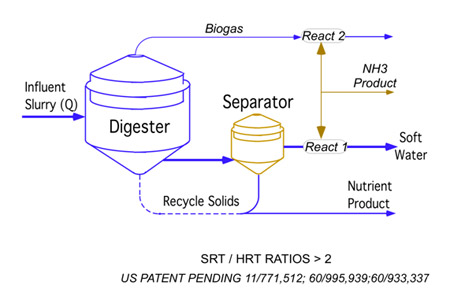Ammonia Nitrogen Recovery
If anaerobic digestion is used to process waste containing protein or other nitrogenous compounds ammonia will be produced and discharged in the effluent slurry. After separation, a majority of the ammonia nitrogen will be discharged with the effluent liquid. Upon discharge a portion of the ammonia nitrogen will volatize as a uncontrolled emission that may form fine particulate matter (PM 2.5), or undergo nitrification / denitrification producing nitrous oxide, a powerful greenhouse gas. The ammonia nitrogen that remains in solution may adversely inpact surface and groundwater.
A variety of technologies have been developed to address the ammonia nitrogen issue. They include biological processes such as the Anammox process or nitrification denitrification and physical chemical methods such as ion exchange or ammonia stripping. All of the available processes are expensive. The physical chemical methods use large quantities of a variety of chemicals that increase the salt content of the effluent. The biological processes convert ammonia to nitrogen gas and thus lose the economic value of ammonia as a fertilizer.
E3's ammonia nitrogen recovery process captures and retains the ammonia nitrogen as a solid product that has significant economic value. The process uses no chemical additives to carry out the physical / chemical separation. The products are soft water having a reduced salt content and a solid ammonia nitrogen fertilizer.
